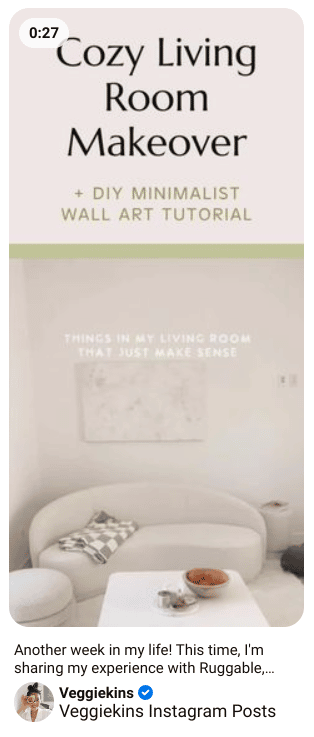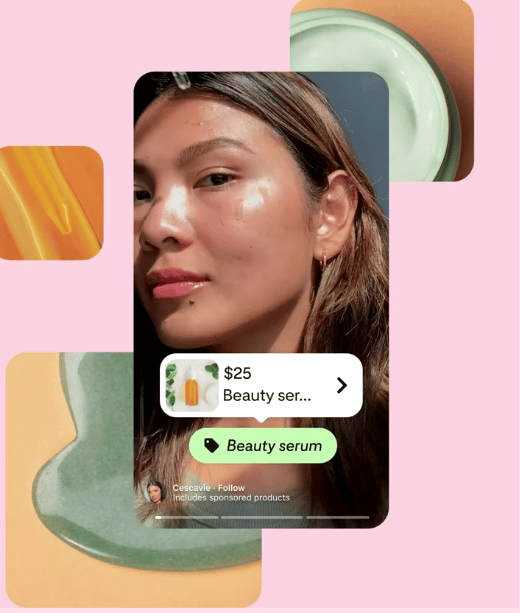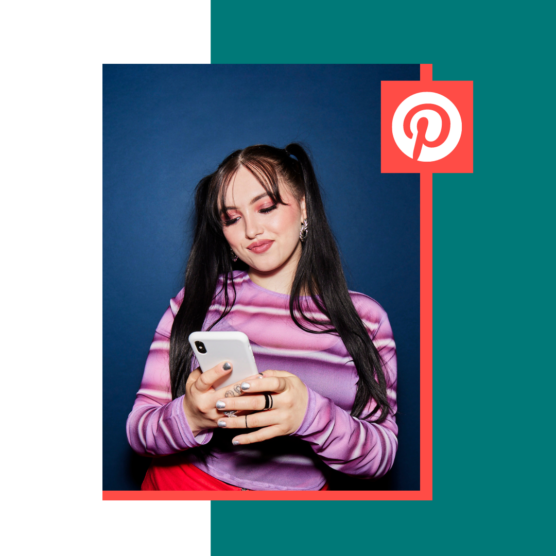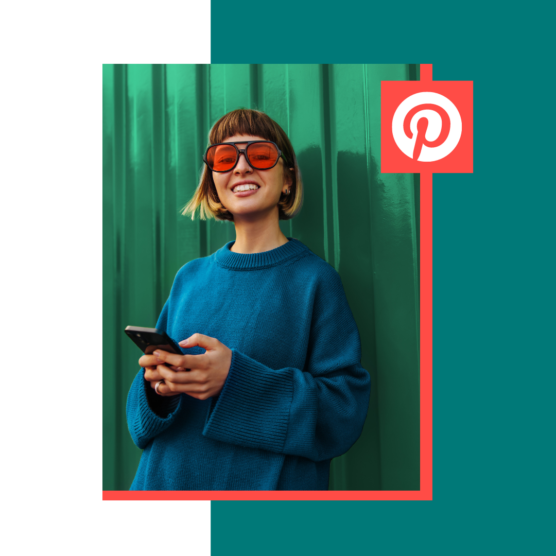If you’re a little lost on how to make money on Pinterest, then keep reading to learn how to turn the visual discovery engine into a revenue-generating machine.
As of Q3 2024, Pinterest has a whopping 537 million monthly active users across the globe. And that audience (reportedly) consumes almost 1 billion videos per day on Pinterest. The revenue opportunities for businesses and influencers are undeniable.
Bonus: Download your free pack of 5 customizable Pinterest templates now. Save time and easily promote your brand with professional designs.
Can you make money on Pinterest?
Yes, especially if you are a blogger, influencer, or eCommerce business. There are several different ways to make money on social media, and the Pinterest tactics that work best depends on your business and your strategy.
For eCommerce or product-based businesses, Pinterest is a great place to catch the eye of customers in the research phase.
80% of Pinners (the affectionate term for people who use Pinterest) say they feel inspired by the shopping experience on Pinterest, which makes it the perfect platform to showcase your products.

If you’re a blogger or influencer, then Pinterest can help drive traffic to your website.
It helps to not think of Pinterest as a traditional social media platform. Instead, think of it as another search engine like Google.
You’ll want to combine SEO strategies and compelling pins to help Pinners find your content and click on the link to your site.
Once on your website, you can redirect them to subscribe to your email list, purchase products, or some other call to action.
These are just a couple of ways you can use Pinterest to make money.
For businesses and influencers looking to monetize their Pinterest channel, read on for foolproof money-making strategies you can start implementing today.
How to make money on Pinterest
Drive traffic with ads
You have to spend money to make money sometimes. Organic reach can only accomplish so much.
For added reach, throw some ad dollars behind your pins. Promoted pins can be optimized to meet different goals like increasing traffic or growing your Pinterest followers.
Promoted pins look just like regular pins, and they are placed in your target audience’s home feed, category feeds, and search results.
There are also different ad types available, like shopping ads, which are pulled directly from your product catalog.
(Don’t worry – we have a simple guide on all things related to Pinterest ads if you need help picking the right type.)
But are ads worth the investment?
Let’s take a look at how Nena & Co. fared when it decided to turn its product catalog into Pinterest ads.
The sustainable handbag brand was able to reach a whole new audience interested in zero-waste and ethically sourced products.
It resulted in an 8x increase in return on ad spend and cost 34% compared to other platforms.

Let shoppers purchase directly on Pinterest
For brands with an e-commerce offering, Pinterest is a natural opportunity to drive traffic — and sales.
Use pins to showcase your goods and direct followers back to your website to shop or use Pinterest’s shopping tool to purchase directly on the app.
The in-app checkout is only available to a limited number of merchants. If you do qualify, you’re in for a real treat.
Pinners can discover your product and buy it without having to leave Pinterest. This streamlines the customer journey and makes it easier than ever to purchase products on Pinterest.
Who qualifies for in-app checkout? You’ll need to meet the following criteria:
- You use the Shopify app
- Shopify store has a U.S. billing address
- Only has Shopify feeds (Meaning you don’t have active non-Shopify feeds uploaded to Pinterest)
- Accepts returns
- Has an email address for customer support inquiries
- Exceeds monthly checkout conversions threshold
- Meets Merchant guidelines
Once you’re approved for the in-app checkout feature, your product pins will have a “Buy” button appear below the pins.
When someone clicks on it, they’ll be able to pick product details like size or color. Then they’ll get redirected to a checkout page within the Pinterest app.
Even if you don’t have the in-app checkout feature available to you yet, you can still create eye-catching pins and direct viewers to visit your website to buy the product.
Become an affiliate marketer
Affiliate marketing isn’t just reserved for blogs. You can also use your direct affiliate links to connect to pins.
By sharing your affiliate links on Pinterest, you can earn a commission on sales if Pinners make a purchase.
Of course, you can also direct people to affiliate-related content, like your blog posts or videos, to warm up your audience before they purchase.
That’s what @veggiekins did with her pin which is linked to a YouTube video containing an affiliate link.

There are some tips and tricks to becoming a successful affiliate:
1. Create board themes
You can’t just create a bunch of unrelated affiliate links, throw them together on the same board, and then expect results.
It’s best to thoughtfully curate pins around a central theme. This helps Pinners discover an overall vision and decide if they want the pinned items to replicate the aesthetics or ideas.
2. Write thoughtful descriptions
You want to express why these affiliate links or pins are important as well as use related keywords and hashtags for Pinterest to use in search results.
3. Be authentic
No one likes it when all you do is promote affiliate links. You need to create pins and boards that authentically represent your brand.
4. Use high-quality media
We’ll get more into what makes a perfect pin later, but you can’t skimp on making inspirational or thought-provoking images or videos for your pins.
5. Follow relevant guidelines on affiliate marketing
Pinterest may block you if it thinks you’re spamming the platform, so it’s best to keep updated with Pinterest’s Affiliate Guidelines and local regulations like the U.S. Federal Trade Commission’s Endorsement Guidelines to ensure compliance.
Help people shop your look
Shopping is a top priority for Pinterest users — 75% of weekly Pinterest users say they are always shopping.
Show off a styled outfit or a sleek space to spark inspiration. Then, tag the specific products in that photo so your followers can shop that look themselves.
This example from Pinterest features a video with a woman demonstrating the multiple beauty products she uses. You can also see the products tagged within the video.

You can use Idea Pins to tag products you want to recommend to your audience.
This makes your pin shoppable and easy for people to find the products you are using. Also a great option for influencers or brands wanting to showcase their products.
Partner with a brand
Influencers and brands go together like peanut butter and jelly. That’s why Pinterest has a paid partnership tool to make it easier for influencers and brands to collaborate and provide transparency about their partnership.
Here’s how it works:
- Make an Idea Pin in the app
- Add the paid partnership label by tagging the brand
- Then they approve the tag
And voila! Your pin now has the brand name listed on the bottom.
Here’s an example of what that looks like:

Brands will pay you to make this type of content and share it with your audience. They may also decide to use the pin as part of their ad campaign.
And yes, there are plenty of brands looking to work with creators.
For example, Gatorade used the paid partnership tool to collaborate with Pinterest’s most popular fitness creators.
Then they used the content for their ad campaign. It led to significant results for Gatorade – the campaign has over 14 million views.

But how do you get these sweet brand partnerships?
You’ll need an engaged, niched audience for starters. You don’t need a ton of followers to get a brand deal. You do need to know how to pitch your brand though.
Join the Pinterest Creator Fund
The Pinterest Creator Fund comes with quite a few perks if you get accepted.
But what is the Pinterest Creator Fund, exactly?
It’s a five-week program where content creators learn about creating inspiring Pinterest content, gain industry insights from experts, and receive potential brand sponsorships.
And did we mention $25,000? It comes in the form of a cash grant, ad credits, and an equipment stipend.
The Creator Fund is a “new initiative focused on the growth and success of underrepresented creators: people of color, people with disabilities and members of the LGBTQ+ community.”

Every quarter, Pinterest announces a new Fund cycle with a themed topic. Cycles have focused on Fashion and Beauty, Food, Lifestyle, Wellness and more.
To be the first to know when the Creator Fund opens, you’ll need to sign up for the Pinterest creator newsletter.
Join the Pinterest Creator Rewards program
You don’t qualify for the Creator Fund? Then see if Creator Rewards is a better fit for you.
Creator Rewards provides a program for creators to earn money by creating original Idea Pins based on Pinterest prompts.
According to Pinterest, “Every prompt will outline specific engagement goals, like getting a certain number of saves, reactions, or takes on your Idea Pin. When you meet the engagement goals, you’ll see rewards in your bank account the following month.”
Pinterest is still in the testing phase of the Creator Rewards program, so a limited number of people qualify to apply.
To be eligible, you need to have:
- A Pinterest business account
- Use the Pinterest app on your phone
- Be 18 years of age or older
- Be a legal resident of, and located in, the United States or the District of Columbia
- Have at least 250 followers
- Have created at least 3 Idea Pins in the last 30 days
- Have 150 saves of your published pins in the last 30 days
- Create original content
You’ll need to check the Pinterest app on your mobile device to see a “Get Started” button to apply.
If you don’t meet the qualifications, then you won’t see this option.
Tips for earning money on Pinterest
It’s never too late to start working on a Pinterest marketing strategy. There are a variety of ways to earn income via Pinterest, as you just read, but all ultimately rely on the power of an audience.
Draw in the eyeballs, and the clicks (and revenue!) will follow. Here’s how.
Follow Pinterest’s Creative Best Practices
Pinterest is a visual platform, so it makes sense that there are high standards for your creative pins to stand out on Pinterest.
Luckily, Pinterest has a whole guide on its Creative Best Practices. It covers everything you need to know on how to correctly format a pin, and what can help make it capture a Pinner’s attention.

When it comes down to it, a successful pin does three things:
- Visually compels you
- Tells a good story
- Makes people interested in learning more
But creating great content isn’t enough – you also need a strategy to get your pin discovered by the right people. That’s where Pinterest SEO comes in.
Implement Pinterest SEO
Keywords are like a meddling matchmaker, bringing content and users together for a love connection.
Using the right keywords to describe your content helps people discover your pins – both through a direct search and through Pinterest’s recommendation algorithm.
You’ll want to incorporate your keywords in places like:
- Pin description
- Text overlay
- Board title
- Board description
- Profile description
Pinterest SEO sounds great, but where do you find the keywords that Pinners are using?
To figure out the best keywords, start with a broad term relevant to your business and enter it into the Pinterest search bar.
Let’s say you’re a travel blogger, and you want to write content about traveling in Mexico. You can type “Mexico travel” into the Pinterest search bar, and below, you’ll see colored tiles that suggest related keywords.

You can also scroll down to find the “Related searches” results for even more keywords.

Click on the keywords to see even more niche suggestions. For example, selecting the keyword “Tips” showed search results for “Mexico travel tips”.
That keyword has even more specific keywords that may not be as heavily targeted by other creators but are still relevant to Pinners.

Based on these results, you could start creating pins suggesting tips on what to pack, tips on taking a road trip in Mexico, and tips on going to all-inclusive resorts. And that’s just a few ideas.
Once you’ve collected your helpful keywords, put them to work — but avoid getting spammy.
Pro tip: Use keywords in rich, conversational sentences, instead of just stuffing as many in there as you can. Don’t forget to add a few hashtags to your descriptions!
Create a media kit
If you’re interested in collaborating with paid partners or hosting sponsorships on your Pinterest boards, it’s worth it to prepare an influencer media kit.
A media kit is a document that features stats about your followers and engagement.
It provides a valuable snapshot of your brand and what it can bring to a company partnership. It may also include prices of specific advertising opportunities.
Use a graphic design template to make a stylish PDF available for download, or feature the information right on your main website or blog.
Once you’ve got this in your toolkit, it’s quick and easy to start a conversation about partnership opportunities.
Schedule your pins
Adding new pins over time — rather than uploading a whole bunch at once — is going to help you reach a wider range of people.
And a scheduling tool like Hootsuite can help you prep your pins to deploy at a just-right leisurely pace.
Embed this Hootsuite video
Batch scheduling your pins is the best way to get in the creative zone with your content — plus it’ll save you from logging into Pinterest six times a day.
As with all social media platforms, you want to make great content to truly succeed – posting content with no value won’t get you anywhere.
So make sure you are creating content you are proud of and provide something inspiring or helpful to your audience.
Save time managing your Pinterest presence using Hootsuite. From a single dashboard, you can compose, schedule and publish Pins, create new boards, Pin to multiple boards at once, and run all your other social media profiles. Try it free today.
![How to Make Money on Pinterest [7 Strategies for 2022]](https://blog.hootsuite.com/wp-content/uploads/2020/11/Make-money-Pinterest-556x556.png)





